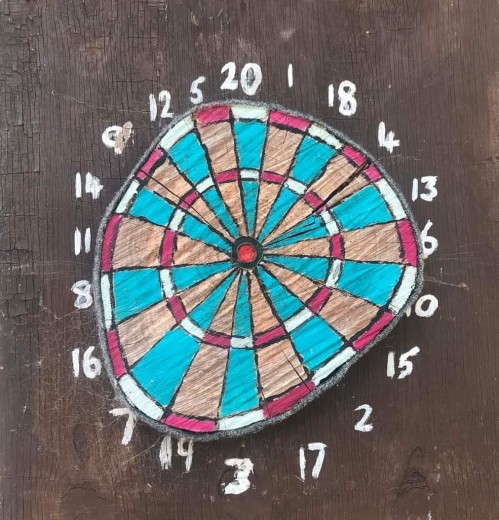Tuesday, May 28, 2019
Column 573
How to Master the Game of Cricket – a book review
Full disclosure: Mesa, Arizona’s Jason Carter and I have a history. It dates to when I took issue with an article he wrote about MAPP (Minimum Advertising Price Policies). It was riddled with inaccuracies and fundamentally argued that American darts suppliers were gouging consumers. “Greedy” he labeled them. They are “ripping off” the American consumer. I was compelled to set the record straight, with facts.
So, when I heard that Carter had written a book – and that the book was about Cricket – my visceral reaction was negative. Carter has also promulgated his opinion that along with “ridiculously” high darts product pricing Cricket has led to the demise of steel tip in this country when, in fact, the predominant cause is a complex stew of years of ADO nonchalance (and possibly worse) and the concurrent rise and professional management of the electronic game.
Thank goodness we have the Championship Darts Circuit guys.
And now, I thought, Carter is a fan of Cricket?
My reaction was unfair. One can’t have an opinion about a book (or the Mueller Report!) unless they have read it.
So, I purchased the book. I’ve read it three times. At 128 pages it’s a quick and interesting read. Carter is a good writer.
I must now admit that my initial reaction was not just unfair; it was wrong.
How to Master the Game of Cricket belongs in every dart player’s library. Both Carter and Dr. Patrick Chaplin, who wrote the Foreword, are correct, at least to my knowledge, that until now, there has been no “book” published that deals exclusively with Cricket. (Note that Chaplin did not “endorse” the book – as a historian he “support(s) research into areas of the sport of darts which have not previously been comprehensively covered in a ‘single volume.’”)
The book, the “volume,” is cram-packed with advice on how to play and excel at the game. The advice is founded on three main principles: 1) don’t chase, 2) point if you’re behind and 3) close if you’re ahead. Nothing earthshakingly new here. These basics are time-worn.
There’s some discussion of counting, using the bull, and more. Again, nothing new.
There are a handful of oddities. Carter, who is described as a “not even decent player” by some who know him, talks about his hitting 7- and 9-marks. Well, maybe. He comments that there is no “video proof” of anyone ever hitting a perfect Cricket game (which is possibly true – but I witnessed a perfect game by Roger Carter in Greensboro years ago and once when calling the ADO Cricket National Final saw him just miss a perfect game against Paul Lim). Carter the author occasionally mixes up steel and soft-tip terms. None of this is a big deal, just curiosities.
Certainly, there is no reason why someone who’s not expert at the line can’t coach others on ways to become expert. And again, the book is full of good advice.
But there is nothing new, nothing significantly new anyway, anywhere between the covers. It’s all there, the first time ever between the covers of any book.
Therein lies a problem, and it is a significant one. Or perhaps to some, entirely insignificant.
Surely the reader is familiar with Yogi Berra Yogi-isms. “You can observe a lot by watching” or “Nobody goes there anymore – it’s too crowded.”
Perhaps the most recognizable Yogi-ism is: “It’s déjà vu all over again.” It’s unclear if Berra said this – he both denied it and copped to it. Some say he said it after the Yankees won the 1953 World Series by defeating the Brooklyn Dodgers for their fifth straight title. Others insist they heard him say it after Mickey Mantle and Roger Maris hit back-to-back home runs against the Chicago White Sox in 1961.
By definition “déjà vu is the eerie and intense sensation that something you are experiencing has happened before.”
Again, there’s the rub.
After reading just the first dozen pages of Carter’s book, I experienced that déjà vu “sensation.” I knew I was reading something I had read before. The words were different. But the message, the ideas, were familiar. I just couldn’t immediately identify the source, not for certain.
So, I began to dig into my library and boxes of old issues of Bull’s Eye News…
Then it struck me. It only took a moment. No doubt about it.
Between the years 1984 and 1998, Bull’s Eye News published a 31-part series by Tony Payne called “Thermonuclear Cricket.” Payne, who among his many other darts accomplishments was a five-time consecutive member of the US World Cup Team, is probably best known for his writings on Cricket strategy.
The unacceptable thing is that nowhere, not on any of the pages of Carter’s book, including the Acknowledgements, does he mention, attribute or credit a single word, phrase or idea to the man who defined and chronicled Cricket strategy. Only a quote from Jay Tomlinson mentions Payne as (historically) “one of the great players east of the Mississippi.”
Carter does acknowledge the “wonderful community of Reddit r/Darts (which)… helped contribute either directly or indirectly to the preparation of this book.”
Along with Carter, one of the most active contributors at Reddit is “misunderstood” convicted sex-offender John Doyle (aka JD Maine, JD, JD3, Sean Murphy, Smurphy, Cyanide, Bruce Kelly and Worldwide Darts). Both Carter and Doyle are moderators at Reddit.
Doyle has also scanned and posted 22 of Payne’s “Thermonuclear Cricket” articles on Reddit and BRANDED some of the articles with his logo (although, admirably, or perhaps accidentally, he doesn’t remove Payne’s byline). What Doyle, or whatever alias he may be hiding behind today, either isn’t aware of or doesn’t care about is that Payne’s articles are copyright protected. People can obtain them by ordering back issues of the magazine. Payne receives a royalty.
One might reasonably argue that in effect what Doyle has done (and Reddit has permitted) is steal sales from Bull’s Eye News and royalties from Payne. Yes, perhaps insignificant to some.
What Carter, who writes, “…it is my hope that these writings will become the ‘bible’ for all things Cricket,” has done is reword, restructure and regurgitate (and supported with graphics strikingly similar to those in “Thermonuclear Cricket”), Payne’s series without an iota of attribution to the man who actually did write the “bible” on Cricket.
Again, none of this is to suggest the book isn’t a useful purchase and packed with good advice. It is. I recommend it, at least to players just starting the game. It’s just that the advice is not original. The honorable thing would have been to acknowledge Payne.
It’s not easy these days to identify which old issues of Bull’s Eye News carried Payne’s series, and even if one makes the effort to purchase one of these back issues some of them are no longer available. But this is no justification for being dishonest, except perhaps to Doyle.
It’s long past time for Payne’s series to be chronicled in one place. No argument there. But the decision should be his.
For the record, I do not know Tony Payne, but I did communicate with him through a friend to ascertain his take on being ripped off. The message I received was not unexpected: “Tony has not read the book and has no plans to do so.”
Why should he?
He wrote it.
From the field,
Dartoid








